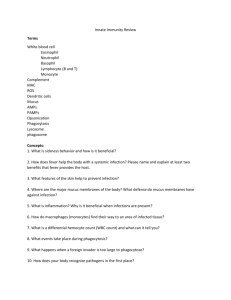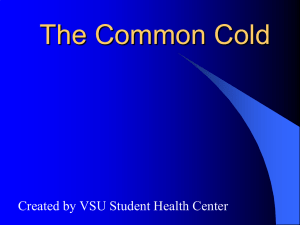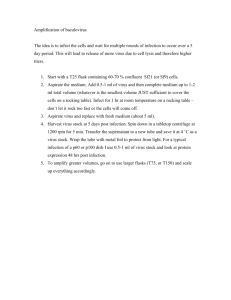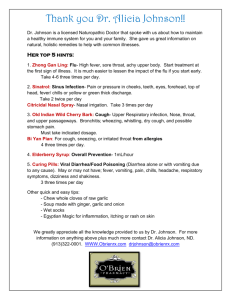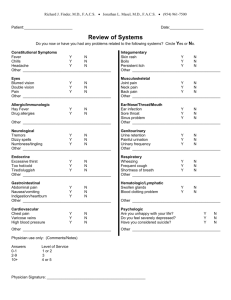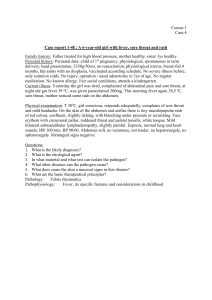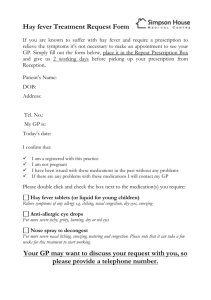C O L D
advertisement
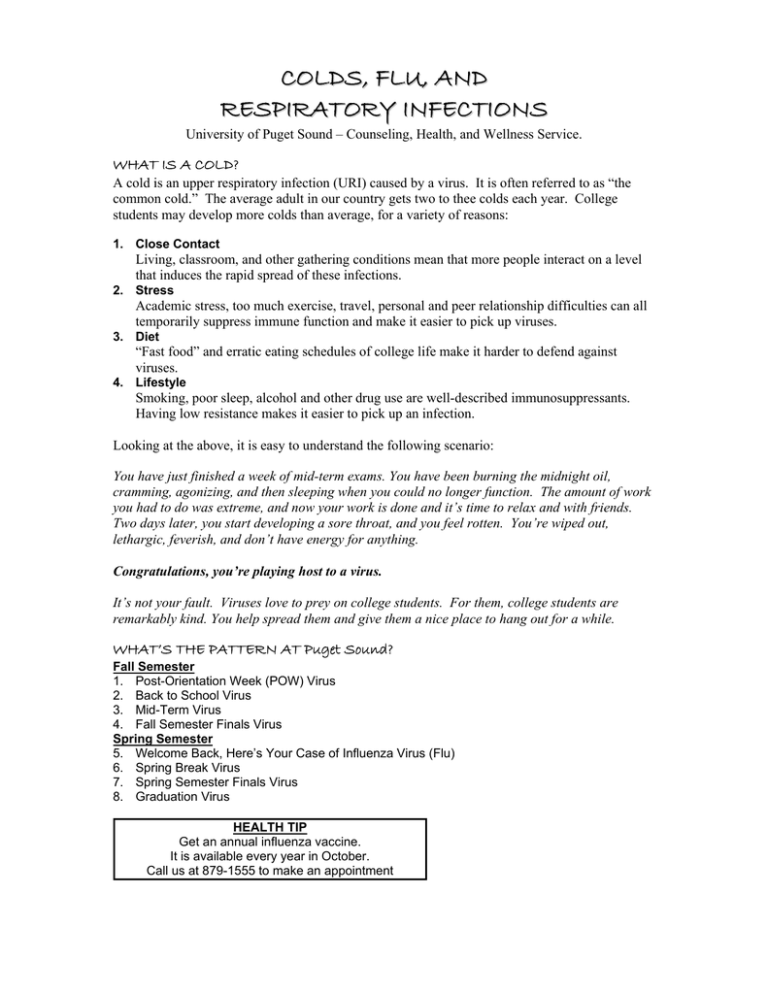
COLDS, FLU, AND RESPIRATORY INFECTIONS University of Puget Sound – Counseling, Health, and Wellness Service. WHAT IS A COLD? A cold is an upper respiratory infection (URI) caused by a virus. It is often referred to as “the common cold.” The average adult in our country gets two to thee colds each year. College students may develop more colds than average, for a variety of reasons: 1. Close Contact Living, classroom, and other gathering conditions mean that more people interact on a level that induces the rapid spread of these infections. 2. Stress Academic stress, too much exercise, travel, personal and peer relationship difficulties can all temporarily suppress immune function and make it easier to pick up viruses. 3. Diet “Fast food” and erratic eating schedules of college life make it harder to defend against viruses. 4. Lifestyle Smoking, poor sleep, alcohol and other drug use are well-described immunosuppressants. Having low resistance makes it easier to pick up an infection. Looking at the above, it is easy to understand the following scenario: You have just finished a week of mid-term exams. You have been burning the midnight oil, cramming, agonizing, and then sleeping when you could no longer function. The amount of work you had to do was extreme, and now your work is done and it’s time to relax and with friends. Two days later, you start developing a sore throat, and you feel rotten. You’re wiped out, lethargic, feverish, and don’t have energy for anything. Congratulations, you’re playing host to a virus. It’s not your fault. Viruses love to prey on college students. For them, college students are remarkably kind. You help spread them and give them a nice place to hang out for a while. WHAT’S THE PATTERN AT Puget Sound? Fall Semester 1. Post-Orientation Week (POW) Virus 2. Back to School Virus 3. Mid-Term Virus 4. Fall Semester Finals Virus Spring Semester 5. Welcome Back, Here’s Your Case of Influenza Virus (Flu) 6. Spring Break Virus 7. Spring Semester Finals Virus 8. Graduation Virus HEALTH TIP Get an annual influenza vaccine. It is available every year in October. Call us at 879-1555 to make an appointment Virologists have some odd names for these viruses, such as rhinovirus, adenovirus, influenza virus, para-influenza virus, etc. Apart from the link to the academic calendar, we see a relationship between year of study and frequency of URIs. Freshmen, transfer students, and other new students tend to get ill more frequently than do returning students. But I can’t afford to be sick right now! ----Who Can? OK, I’m sick. Now what? For most young, healthy adults, viral URIs are a nuisance, but don’t usually result in any significant health problems. A small percentage go onto develop more significant, or secondary infections, such as bronchitis or an ear infection. Individuals more likely to have a prolonged infection or to develop secondary infections are those with chronic health problems, such as diabetes or asthma. I always got antibiotics in the past for these symptoms, why not now? Antibiotics were often overused in the past, but research shows that they are ineffective in viral illnesses. Misuse of antibiotics may cause dangerous allergic reactions and drug resistance, so that when you truly need an antibiotic, it may not work as well. If you have concerns, please talk to your health care provider. If your symptoms worsen, please return to Counseling, Health and Wellness Services for re-evaluation. SYMPTOMS Usually, a cold starts off with a sore throat, headache, decreased energy, and body aches, chills or fever. The sore throat usually disappears after a few days, but is gradually replaced with a runny nose, often quite watery. Then nasal congestion develops, and the mucus becomes thick and yellow. The next symptoms are a cough and chest congestion. Frequently, as the cough develops, the initial “I really feel lousy” symptoms get better. The time course depends on a variety of factors, but can be as short as a few days or as long as a few weeks. Some colds are more severe than others. FEVER is probably the most misunderstood of any symptom. You may have heard the following, “My usual temperature is 96 F, so if I have a temp of 98 F, it is really a 2 degree fever”. This is totally without basis in fact. A fever is an oral temperature > 37.2 C (98.9 F) in the AM or > 37.7 C (99.9 F) in the PM. Fever is only one of the signs of disease. The presence or absence of fever doesn’t necessarily determine how sick you are. You can be sick and feel feverish without having an elevated temperature. TREATMENT Although medical research is constantly developing new anti-viral medications, there is not yet any specific treatment for colds. Antibiotics do not shorten the length or severity of a cold, and may make things worse. Currently, treatment is aimed at relieving symptoms. Medications are NOT required, but may help you feel better. • Lozenges – help soothe a sore throat • Decongestants – relieve nasal and chest congestion • Expectorants – help make thick yellow mucus thinner and easier to clear. Also moisten dry mucus membranes. • Cough Suppressants – decrease coughing • • Acetaminophen (Tylenol) – helps relieve body aches, headaches and fever. Nasal Decongestant Sprays (Afrin) – will relieve nasal stuffiness, but beware of prolonged use. Use twice daily for no longer than 3 consecutive days. REST is critical in overcoming any infection. The more you rest early on in the illness, the more time you’ll save being sick later. Don’t push it – REST!! Some Natural Remedies: Peppermint, Menthol – soothes irritated mucus membranes & relieves nasal congestion Peppers (Chile) (e.g., Jalapeño) – have an expectorant effect & relieve congestion Tea – black, green, or herbal – relieves congestion and soothes your throat Salt-water gargles (1/2 tsp. salt in one cup of warm H2O) soothes your throat & moisturizes mucus membranes Salt-water nasal spray – reduces swelling & dryness of nasal passages and can be purchased at a pharmacy. Do not make your own concoction! Table salt can be caustic to nasal membranes. Steam – moisturizes mucus membranes and relieves congestion Vitamin C – may help you feel better in the initial stages (500 mg/day) Zinc – may help your throat and fight infection, although not fully proven Echinacea – may help if taken at the onset of symptoms, but not recommended long-term WHAT TO WATCH OUT FOR: Although the vast majority (>95%) of colds resolve without difficulty, a small number of patients will go on to develop a secondary infection which may require specific treatment. Examples include ear infection, sinus infection and pneumonia. These usually develop late in the “cold” illness, i.e., more than 7 to 10 days after the cold starts. Keeping an eye out for these complications and getting prompt treatment can shorten the duration and lessen the severity of these conditions. • Prolonged fever • Prolonged cough • Persistent pain in an ear • Prolonged sore throat, especially with increased difficulty swallowing • Unusual or different symptoms from a typical “cold” • Facial pain HOW TO PREVENT A VIRAL URI: Because respiratory viruses are spread by person to person contact, practice frequent and good hand washing. Take good care of yourself: get adequate, regular rest exercise regularly eat a well-balanced diet relax stop smoking (better yet, don’t ever start) abstain from or limit alcohol consumption. Avoid close contact with infected persons Significant content borrowed with permission from a Rice University Student Health Service brochure
